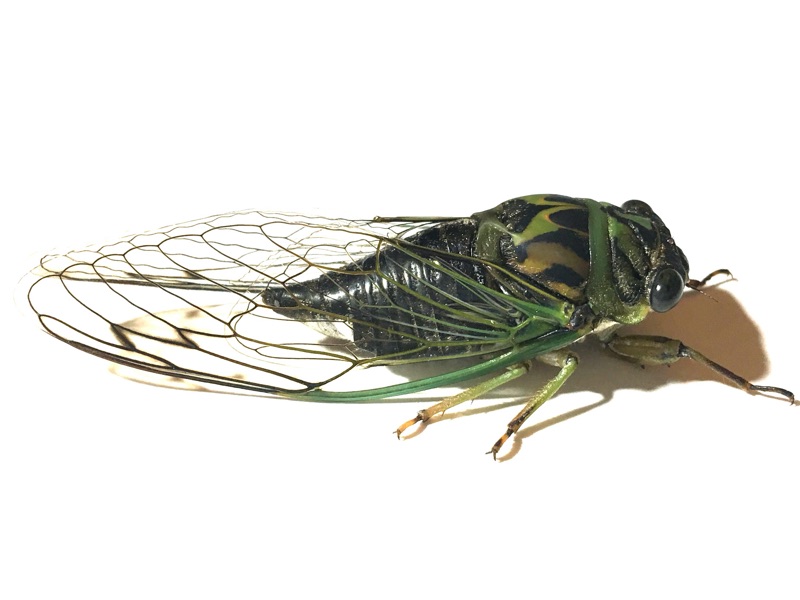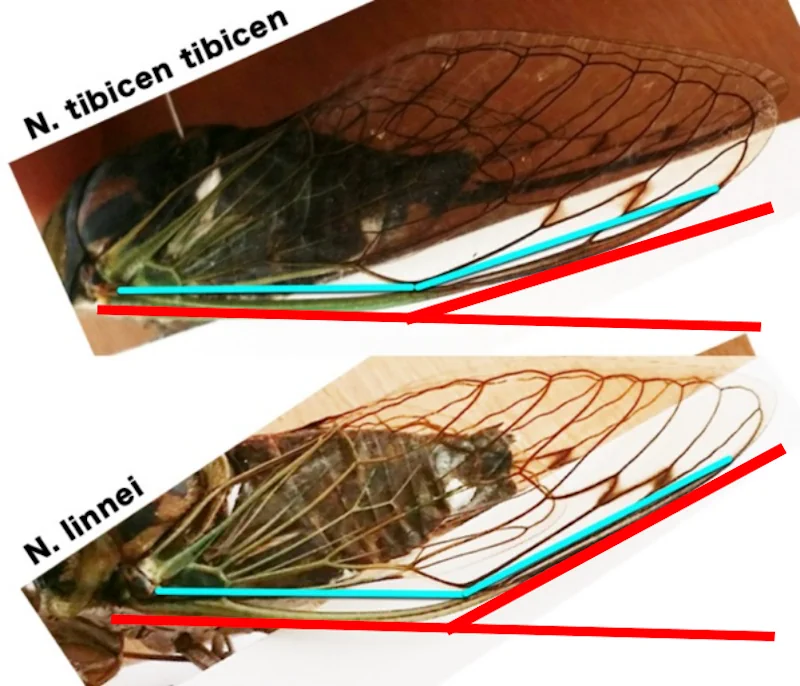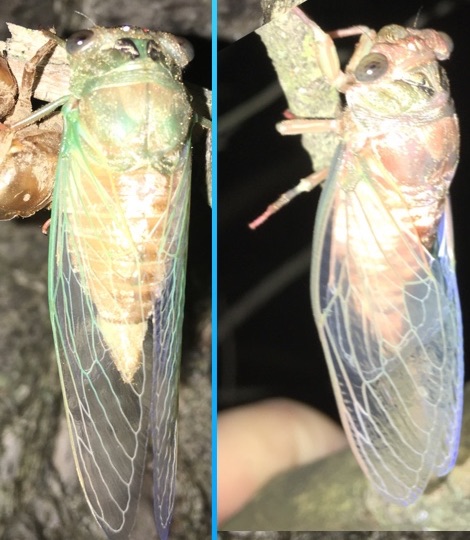Neotibicen linnei (Smith and Grossbeck, 1907) aka Linne’s Cicada.

Photo by Dan Mozgai.
See all Neotibicen linnei images & information about cicadamania.com.
Song type: Call
Source: ©Insect Singers
Video Playlist
Playlists contain multiple videos found on YouTube.
Name, Location and Description
- Cicada Name: Neotibicen linnei (Smith and Grossbeck, 1907)
- Short Name: N. linnei
- Common Name: Linne’s Cicada
- Synonym/Former Name: Tibicen linnei
- When: July-September. Peak in August.
- Where it is found: AL, AR, CT, DE, DC, FL, GA, IL, IN, IA, KS, KY, LA, ME, MD, MA, MI, MN, MS, MO, NE, NJ, NY, NC, OH, ON, PA, SC, TN, VT, VA, WV, WI
- Maps: Biogeography of the Cicadas (Hemiptera: Cicadidae) of North America, North of Mexico [PDF]
- Description: Black, green and some brown camo pattern. Prominent M. Bend in its wing. Sounds like N. tibicen.
- Eye Color: dark brown
- Pronotal Collar Color: green
- Identification: Bug Guide
- Identification: iNaturalist
- Subject Matter Expert website: Cicada Central
- Taxonomic Information: Integrated Taxonomic Information System
- Song: Insect Singers
A description of linnei by Wm. T. Davis from Mississippi Cicadas, with a Key to the Species of the Southeastern United States1
The female of this species often closely resembles that of T. pruinosa [Neotibicen pruinosus], but in linnei the fore wings are abruptly bent near the middle, whereas in pruinosa the curve is more regular. The song is very different from that of pruinosa and is a continuous z-ing, but generally of short duration.
Identification Key by Wm. T. Davis:1
A. Large, heavy bodied species ; head broad, uncus simple, and first cross vein in the fore wings starting from radius 3 far back, or about one third distant from base of first marginal cell.
B. Uncus longer than broad. Black species with green or greenish markings and black area on the central part of the abdomen beneath
C. Hind margin of pronotum or collar, green or greenish.
A longitudinal band of black on the under side of the abdomen, the opercula more lobate, and the margin of the front wings suddenly bent near the middle.
Example of the wing bend:

What this cicada looks like when it is still soft
Color varies, even from the same location:

Classification:
Family: Cicadidae
Subfamily: Cicadinae
Tribe: Cryptotympanini
Subtribe: Cryptotympanina
Genus: Neotibicen
Species: Neotibicen linnei (Smith & Grossbeck, 1907)
List of sources
- Davis, W.T. 1918. Mississippi Cicadas, with a Key to the Species of the Southeastern United States. Journal of The New York Entomological Society. Vol. XXVI. Read on archive.org.
- Full Binomial Names: ITIS.gov
- Common names: BugGuide.net; The Songs of Insects by Lang Elliott and Wil Herschberger; personal memory.
- Locations: Biogeography of the Cicadas (Hemiptera: Cicadidae) of North America, North of Mexico by Allen F. Sanborn and Polly K. Phillips.
- Descriptions, Colors: personal observations from specimens or photos from many sources. Descriptions are not perfect, but may be helpful.
Notes:
- Some descriptions are based on aged specimens which have lost some or a lot of their color.
13 replies on “Neotibicen linnei (Smith and Grossbeck, 1907) aka Linne’s Cicada”
I just found one of these things in ON Canada. Never seen one before, it’s so bizarre looking, but so cool too!
I found this guy on my patio in Austin, TX. It doesn’t appear that Texas is a normal area so have I misidentified it?
I just seen a superb green cicada in Massachusetts! Was on a car tire, saw me, flew around, then flew off. Weird timing?
N. superbus isn’t found east if the Mississippi River, are sure that it was that species?
I hear these noises a lot in the summer.
Earlier tonight in northern VA I heard a linnei (pretty sure second of the season) and I didn’t know these went this far south? I’ve heard them in WV and NY but not here before.
Also, does canicularis go down south as far as Virginia? I thought I heard one in July, or maybe it was one of the other species like davisi
Hi,
Yes to both canicularis and linnei. Both are in Virginia. Virginia also has Neotibicen davisi which sounds like canicularis.
Common cicadas of Virginia
Alright.
Is there any difference between the canicularis and davisi? I know it has a smoother call than lyricen (without the rattling)
Just found a recently deceased one in the park (Baltimore, MD) and pinned it. Beautiful wings! I’ve been hearing these for the past 2 weeks and saw lots of holes on the ground by nearby trees.
I found several of these cicadas on the ground under my gum trees. I’m wondering which brood they are. There are not that many. They sing very late in the afternoon, near to dusk. Would appreciate any info anyone could send me about them.
The cicadas out now are annual species and don’t belong to a brood (only the 17/13 year cicadas are organized by brood.You can listen to the sound files on this page to narrow down the species https://www.cicadamania.com/cicadas/common-cicadas-of-north-america/
Last year, my wife and I found three shells of emerged and empty cicadas. The other day, I found a shell of a cicada that morphed. That shell has the thorax and abdomen (which was with the thorax, but separate.
I kept them all and am wondering if anyone would be interested in pics of them and/or recordings no of their sound (which is happening right now and was clearly audible at 2am last night?
I don’t know which brood they are.
Please advise.
We live on Tybee Island, Georgia.
@Michael, it might have been cicadas with annual lifecycles. Here’s a list of cicadas in Georgia.
At night, some cicadas will sing in the presence of artificial light, when it is very hot or there’s a lot of them — but usually at night it’s a katydid or frog making the noise.